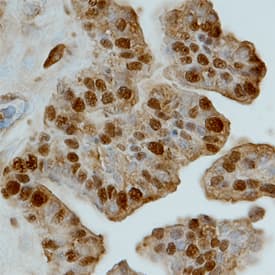Human TCF7L1 Antibody
R&D Systems, part of Bio-Techne | Catalog # MAB61161

Key Product Details
Species Reactivity
Validated:
Cited:
Applications
Validated:
Cited:
Label
Antibody Source
Product Specifications
Immunogen
Lys429-Ser581
Accession # Q9HCS4
Specificity
Clonality
Host
Isotype
Scientific Data Images for Human TCF7L1 Antibody
TCF7L1 in Human Brain.
TCF7L1 was detected in immersion fixed paraffin-embedded sections of human brain (hippocampus) using Human TCF7L1 Monoclonal Antibody (Catalog # MAB61161) at 15 µg/mL overnight at 4 °C. Before incubation with the primary antibody, tissue was subjected to heat-induced epitope retrieval using Antigen Retrieval Reagent-Basic (Catalog # CTS013). Tissue was stained using the Anti-Mouse HRP-DAB Cell & Tissue Staining Kit (brown; Catalog # CTS002) and counterstained with hematoxylin (blue). View our protocol for Chromogenic IHC Staining of Paraffin-embedded Tissue Sections.Applications for Human TCF7L1 Antibody
Immunohistochemistry
Sample: Immersion fixed paraffin-embedded sections of human brain (hippocampus)
Formulation, Preparation, and Storage
Purification
Reconstitution
Formulation
Shipping
Stability & Storage
- 12 months from date of receipt, -20 to -70 °C as supplied.
- 1 month, 2 to 8 °C under sterile conditions after reconstitution.
- 6 months, -20 to -70 °C under sterile conditions after reconstitution.
Background: TCF7L1/TCF3
Transcription factor 7-like 1 (TCF7L1; also HMG box transcription factor 3, TCF-3) is a 63 kDa member of the TCF/LEF family of proteins. Human TCF7L1 is 588 amino acids (aa) in length and contains one HMG box DNA-binding domain (aa 346-414). Human TCF7L1 shares 95% aa sequence identity with mouse TCF7L1. TCF7L1 is expressed in hair follicles and skin keratinocytes and at lower levels in stomach epithelium. Functionally, it participates in the Wnt signaling pathway. TCF7L1 binds to DNA and acts as a repressor in the absence of CTNNB1 and as an activator in its presence. TCF7L1 is also necessary for the terminal differentiation of epidermal cells, the formation of keratohyalin granules, and the development of the barrier function of the epidermis.
Long Name
Alternate Names
Gene Symbol
UniProt
Additional TCF7L1/TCF3 Products
Product Documents for Human TCF7L1 Antibody
Product Specific Notices for Human TCF7L1 Antibody
For research use only
